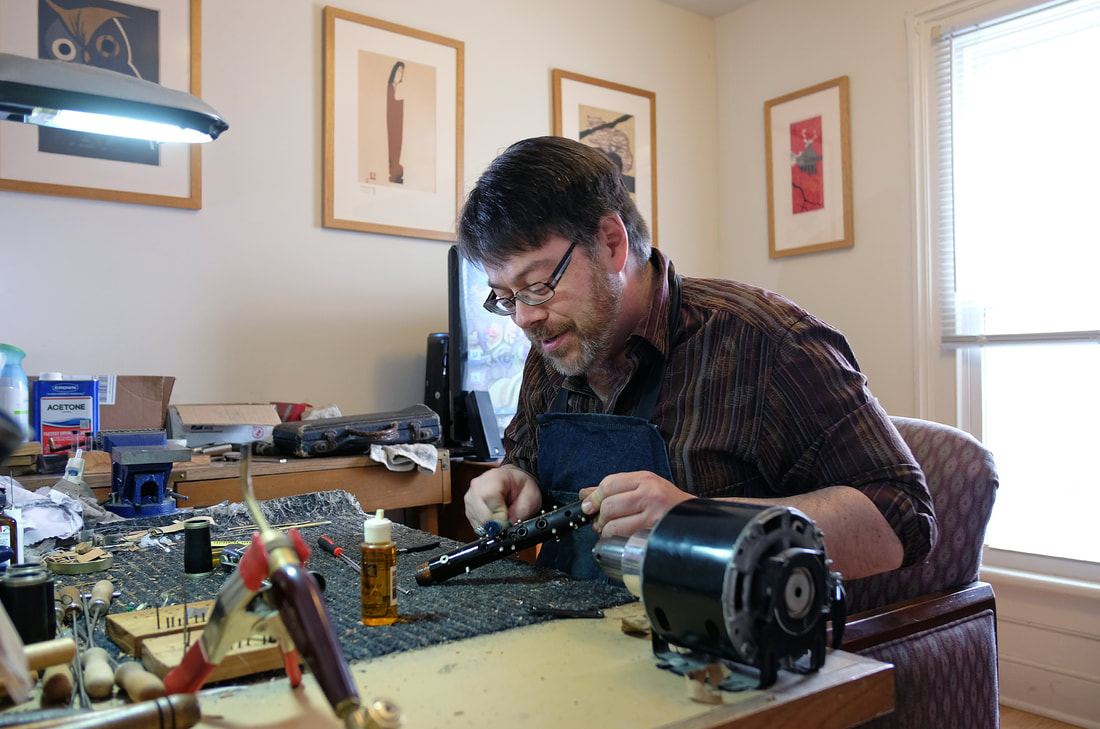 For the many years before the Vintage Clarinet Doctor did repair, I'd turn one of my instruments over to a repairman with mingled optimism and dread. Does he know what he's doing? What does 'overhaul' really mean? Why does one person charge significantly more than another? Are there any approved procedures or industry standards, or does anything go? I'd like to address a few of those concerns, and try to shed light on some of the mysterious things that a good tech does (or should do) to a horn: On a newer plastic student horn, a re pad might only include dis-assembly, washing the body, quickly hand-ragging the keys, replacing missing corks, replacement of all pads, reassembly and adjustment: about a 2 1/2 hour job for about $150. For an instrument with fresh tone-holes, snug posts, tight mechanism, shiny nickel plated keys and recent springing this might be sufficient, especially if its going into the hands of an 11 year old of indifferent ability. An overhaul, on the other hand, would include everything necessary to return the instrument to as close to 'like new' playability as is feasible (sometimes extraordinary measures are not justified by the value of the instrument), and address the preferences of the more advanced player in question. This might include: Swedging/countersinking the key-work to remove lost motion, re-facing of tone-holes to assure optimal pad seat, tightening of loose posts, replacement of all cork (including adjustment of opening height to regulate tone and intonation), thorough oiling of body, buffing of body, posts and keywork, polishing of the bore, straightening or leveling of bent keys, key cups and rods, realignment of keys with tone holes, replacement of weak springs, repair of small cracks or chips, installation of a mix of high quality leather and cork pads, reassembly and adjustment, and re-gilding the logos! Total of 6-10+ hours depending on age, complexity of mechanism, and condition. To Be Continued....
0 Comments
 I ran into a first this week: a customer who managed to spill a can of soda across BOTH his A and Bb clarinets: it was a pitiful sight! They had sluggish keys, pads stuck to tone holes, and a nice glaze on the wood bodies. I started by disassembling and cleaning all surfaces with a Q-tip: tone-holes, keys, rods, screws, body and (especially) pads. I then dried affected parts with a soft cloth, oiled the screws and rods, and reassembled. One pad's leather actually tore loose, from the adhesive qualities of the soda, and had to be replaced! Some welcome income, but a sorry sight and one that I hope I won't be dealing with again soon.... Now, why do I bring this up? Well, soda (and other sweetened drinks) aren't just rough on the outside of your horn, they're rough on the inside, too! I used to see student instruments with sticky pads, and my boss explained that they were the victims of soda or juice consumed directly before playing, which ended up condensing on the pads. Much better to stick with water, or at least rinse your mouth after consuming a sweetened drink and BEFORE you pick up that horn! And for goodness sake, please keep that container away from your case. A word to the wise.... |
Archives
February 2024
AuthorThe Licorice Shtick Blog is the creation of the Vintage Clarinet Doctor, a Winston Salem, NC based woodwind instrument repair shop specializing in vintage and antique clarinets, saxophones, and the occasional flute. Categories |

 RSS Feed
RSS Feed